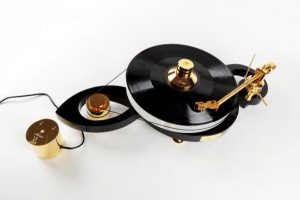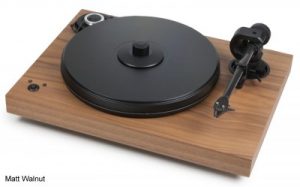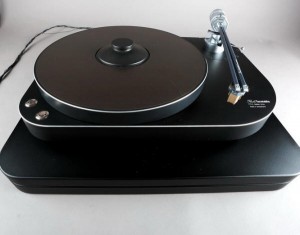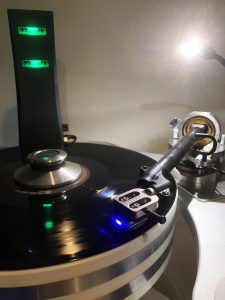During the audio shows you can find both, interesting and boring things, new and vintage designs, big and small ones. But also the ones that you respect right from the start, and those that you do not even know whether to laugh or cry about. The loudspeakers and turntables often belong to the latter category. The reason for crying and / or laughing is a popular tendency to make bigger and bigger, or even huge devices. How else could one react seeing a turntable as big a two-door wardrobe? Or heavier than half of one's apartment?
Maybe it is not an objective opinion at all, but only my own feelings? With age, I have more and more inclination towards elegant and minimalist solutions. While I appreciate efforts towards better and better sound quality, which often can get quite complex, my heart goes with simplicity.
So when I saw for the first time, thanks to the Jürgen Straussman, who unfortunately is no longer with us, his turntable, I immediately fall in love with it (see HERE). The Cantano by KlangwellenManufaktur, the work of Mr. Oliver von Zedlitz, was the only components in Jürgen's system, except for the loudspeakers, that was not built by him. They both were proud of how well it sounded, praising also the Ortofon Anna MC cartridge they used. Let me add that they were also both proud Berliners.
A few simple words…
PHILIPP PETZKA
Head of International Distribution
Pan Oliver von Zedlitz in Krakow
Oliver von Zedlitz is the owner of CNC-Gronemann GmbH in Berlin, which is producing the Cantano turntable. Main field of business of CNC-Gronemann GmbH since 50 years is the production of high precision parts for medical use or laboratories. He was and is, as many others too, a big music fan, especially played on vinyl.
It turned out, that turntables available on the market were not really satisfying his understanding and requirements of a "good" listening experience. "All-rounder" capabilities and especially vitality of sound have been missed out too often. So, with his company background, he started to develop an own turntable with the simple goal to "produce the best turntable ever". That is meanwhile 13 years ago and Cantano turntables has been shifting in shapes several times. Hundreds of materials and combinations of them have been tested, lots of concepts have been went through.
Although, Oliver and his team are still passionately in continuous search for improvements, which is and will be a never-ending story, with the Cantano W/T they are finally confident to conquer the audiophile world globally. Hereby, the quality of Cantano turntables is arising from most advanced possibilities of manufacturing due to CNC background and, of course, time. The main principle, to reach vitality of sound, is not to reach a good sound while damping parts, but through the perfect combination of used materials and precisely perfect manufacturing.
Mr Philipp Petzka, International Sales Manager. While unpacking the turntable in Krakow
Here is a short description of differences between the previous Cantano, that Mr. Wojtek Pacuła listened to a few years ago in Berlin, and the current Cantano W/TA:
- the tonearm is exchangeable now. Current solution allows to exchange the tonearm without any cable clips, which could lead to reductions in sound quality
- the tonearm (Cantano T) is now made to carry most kind of cartridges
- materials have been changed: Base of the TT. Is now a solid slate plate, not granite anymore
- the current model has a wooden frame around the slate. 4 kinds of wood are available
- the new bearing with small spiral oil channels for lifetime lubrication (no invert bearing anymore)
- the new Tonearm has no outside visible damping anymore
- we now provide our own reference motor with own power adapter
Cantano W
Almost seven years later Mr Oliver von Zedlitz knocked on my door. Together with the sales manager, they brought a wooden box to my third floor, from which they extracted a turntable that looked very similar to what I saw in Berlin, armed with a tonearm that also seemed familiar to me. As it turned out, there are many things in their designed that have actually changed since my first encounter with Cantano. First of all, not only turntable, but also the company is now called Cantano and it now belongs to CNC-Fertigung Gronemann GmbH. Mr. Olivier is still the boss and chief designer, but the turntable has undergone a major metamorphosis.
What is left from the original model is primarily the silhouette and a general idea. This is a minimalist, non-suspended turntable, with a belt drive and an external motor. Both the base and the main bearing module have a beautiful silhouette and, at first glance, seem very simple to built. The devil is in the details though, including the precision of the components making. In the general the model W—because that's how it is called—resembles the designs of Simon Yorke (e.g. S-10). There is a tall module with the main bearing that is smaller in diameter than the platter.
Unlike the S-10, the W model is equipped with a base that performs an important role here because it is a vibration damping element. It was built of slate with a wooden frame. Slate is used by some companies as a dissipative element, but it is a material difficult to work with. You can find it, for example, in such products as: Transrotor La Roccia TMD (Polish) and Stacore Advanced anti-vibration platform, and the new Super Sound Device amplifier. The wooden that envelopes the slate is available in four different finishes.
The platter consists of two elements. The lower one is made of aluminum on CNC machine, with a tolerance of 0.01%. Its upper part is en expensive and difficult to process graphite in a specially selected version and different than in the previous model finish. The main bearing is mounted in the steel module underneath. It consists of a hardened steel and a silicon carbide sinter axle that rests on a sapphire ball. Five grooves were made on the walls to lubricate the bearing with proper oil. The turntable features also a heavy record clamp placed on the axis. On request, the company can equip the turntable with a magnetic support for the platter, which, to a large extent, though not entirely, reduces axle pressure on the sapphire ball.
The motor is encased inside a steel cylinder. It is placed next to the turntable, on the left. The belt tension can be set experimentally. The company offers two types of belts with smaller and bigger compliance, and the choice also affects the sound. A small switch on top of motor's housing turns rotation on, another switch allows user to change the speed (33 1/3 or 45 rpm). The wheel on which the rubber belt with a square cross section looks like it was made of a material called POM. The motor is currently powered by an external power supply, which has been developed by Cantano. Over the years, the company used very good electronics from Klein that was still displayed on manufacturer's website at the time of this review. However, the latest version was delivered for the test.
The turntable features three feet consisting of a steel cone, screwed on a threaded stem, and an aluminum base. The cones are bolted to the stem with Allen screws, which gives them exceptional stability.
Cantano T
The T tonearm is a 12'' uni-pivot, but due to precision machining its weight is close to that of a typical 9" arm. It is made of titanium on CNC machine, and it features several steel elements. The headshell is small, round and bolted with the tonearm with two screws. The two elements stabilizing the arm horizontally are also made of titanium. The counterweight is made up of three wheels, screwed to the steel stem. The Anti-skating solution is based on a spring screwed to a curved spindle. The arm is attached to a rigid steel boom, and the boom to a slim column. The VTA adjustment is available, but it is not easy to repeat same result twice, because to change VTA one needs to unscrew the clamp on the arm column, but there are no indicators that would allow one to achieve exactly the same result the next time one performs this operation.
Internal cable features a silver-plated copper wires soldered to gold-plated RCA sockets. These are fixed on a curved metal element behind the tonearm.
This is a really great, elegant looking turntable.
TEST METHODOLOGY
The turntable was set up in my house by Mr. Oliver von Zedlitz. It was placed on Finite Elemente Pagode Edition's top shelf. I have used my trusted Miyajima Laboratory Madake cartridge and the RCM Sensor Prelude IC phonostage. To setup the cartridge according to Baerwald's geometry I used Mr. Feickert's protractor. The turntable was connected with a phonostage with Crystal Cable Absolute Dream interconnect, and phono with a line preamplifier—Ayon Audio Spheris III—using Siltech Triple Crown interconnect.
CANTANO in High Fidelity
- TEST: KlangwellenManufaktur CANTANO turntable
SOUND
Records used for the test (a selection)
- Denon Jazz in New York, Nippon Columbia ST-6004, "6th Anniversary", LP (1978)
- Bill Evans, Bill Evans Live At Art D'Lugoff's Top Of The Gate, Resonance Records HLP-9012, "Limited Edition - Promo 104", 45 RPM, 3 x 180 g LP (2012)
- Billie Holiday, Lady Day, Columbia/Pure Pleasure PPAN CL637, 180 g LP (1954/2010)
- Brendan Perry, Ark, Cooking Vinyl/Vinyl 180 VIN180LP040, 2 x 180 g (2011)
- Depeche Mode, Where’s The Revolution [Remixes], Columbia Records 42003, 2 x 180 g LP (2017)
- Dire Straits, Brothers in Arms, Warner Bros./Mobile Fidelity Sound Lab MFSL-2-441, "Special Limited Edition No 3000", 45 RPM, 2 x 180 g LP (1985/2014)
- Duke Jordan Trio, So Nice Duke, Master Music MSA-001, "Harmonix Master Sound", 180 g LP (2017)
- Ella Fitzgerald, Ella Fitzgerald sings the Cole Porter Song Book, Verve/Speakers Corner Records MGV 4001-2,2 x 180 g LP (1956/2000).
- Julie London, Julie is her name. Vol. 1, Liberty Records LPR 3006, LP (1955)
- Semafor Combo, Semafor Combo, OBUH V30, 180 g LP (2012)
- Tsuyoshi Yamamoto Trio, Midnight Sugar, Three Blind Mice/Cisco TBM-23-45, "Twenty-Fifth Anniversary Limited Edition | No. 0080/1000", 45 RPM, 2 x 180 g LP (1974/2004)
The thing that I remember perfectly from listening to the first version of the Cantano turntable and tonearm was the dynamics—remarkable that reminded me of what I knew from live performances, and to a large extent repeating what I knew from analog master tapes. Straussman's whole system was focused on this element of presentation, and it was clear that this innate weakness of the recordings was targeted, but it was this turntable, along with Ortofon's cartridge, that dictated the whole direction. You do not have to be born with "golden ears" to confirm the prominence of this aspect of presentation also with the W and T versions of this turntable and arm. Unlike back then, this time I found this sound much denser and richer, simply put—much better.
In terms of tonal balance, the German design is much closer to that of the Air Force Two (141 500 PLN + tonearm) by Japanese TechDAS, as well as the Model 20/3 (Polish) by British SME (around 100 000 PLN). Quite a different tonal balance is offered by Kronos Sparta (140 000 PLN) with Helena tonearm or Acutus Reference by Avid HiFi with SME V (around 75 000 PLN). At least it seemed so after a short listening session. In a long run everything started to change and I began to perceive its performance in the same categories as the Döhmann Helix 1 (180 000 PLN). And finally I stopped comparing it with any other turntables at all.
The music played through Cantano is interesting in itself, no matter how it was recorded. This of course varies depending on which disc I listened to, but even with those records that I rarely reach for, I was engaged in the presentation, both emotionally and intellectually. Emotionally, because it turned out that I "rejected" some of those records unfairly and if only the proper setup is used, they have a story to tell, and intellectually because Cantano serves an interesting performance, saturated with information, detail but also pulsating with subcutaneous "beat", so I could compare them even with the best ones.
The tonal balance of this turntable is very neutral. It offers a nicely extended treble and low, very low bass, but these band's extremes never dominate the presentation. They are a part of a larger whole, even in the recordings that were prepared to impress listeners with bass, such as "Wintersun" track from the Ark album by Brendan Perry or those in which the cymbals are highlighted and too powerful, as they are on the 2-disc Depeche Mode album Where's the Revolution. In both cases the properties of the recordings were legible, unequivocal, but never dominated the music.
This turntable perfectly differentiates recordings, although at first glance it is not particularly exhilarating. For example, the sound is not warmed up, but it is often warm. When I played the original, monophonic release of Julie London Julie is her name ... Vol. 1 I heard an extremely low, warm vocal. That's how, at the time, this type of mono recordings were prepared, because the Nat 'King' Cole's and Dean Martin's recordings from this period sounded very similar. In comparison, the stereo versions are much brighter, harsher. The Cantano perfectly captivated the intentions of sound engineers and producers who wanted to convey the intimate side of Julie London's voice and tangibility of Bernie Kessel's guitar, but keeping them nicely separated.
In turn, when I placed a record on the platter with high dynamics and properly presented leading edge of the sound, then Cantano immediately caught up with this type of presentation and delivered, for example, the Tsuyoshi Yamamoto's piano from the album Midnight Sugar album in the way that only the best turntables do, such as Döhmann Helix 1. These two designs share the ability to present the full dynamic range, which by most turntables is slightly limited/sacrificed for other purposes.
Here everything is perfectly balanced. When I listened to the London's album I thought that it was a turntable created for vocals, focused on a warm, lower midrange. When I listened to Perry, or Kraftwerk I thought it was perfect for presenting wide soundstage, powerful bass and so on. Every time, with every type of music, it sounded differently. Without imposing its own character and without directing my attention to the specific aspects of the sound.
Each time the sound was dense and focused, with great weight and dynamics. The latter is often associated with a rather bright sound, because it is easier to show the attack, the speed if one chooses to tune the sound a bit dialing down on its richness. Not in this case. Richness, saturation of the sound are the key to Cantano's sound. Double bass, kick drum, bass guitar, vocals, piano—all these elements have a solid support, that makes listener "flow" with the music, and not fight against the flow.
This aspect of the presentation comes from the remarkable resolution of this turntable. The class of device can be easily identified by focusing on the relationship between resolution, selectivity and detail. The German turntable delivers information, not details. What does it mean? Firstly it sounds like music, not sounds, and secondly one can hear a lot of things, but without been able to say why, at least not at first. Like, for example, the differences between digital and analog recordings.
The latter are a bit more dull and less dynamic with this turntable. But if it's a good recording, like Denon's 1970s PCM ones, we get a lot of music with that. On the other hand, if it is a modern digital recording and therefore modern pressing, the presentation is simply boring, not exciting. Normally these differences are presented as harshness, issues with dynamics, etc. Once you listen to them on Cantano, you will know much more about them.
What with the most expensive turntables is different, sometimes better, is, for example, scale of the sound. The TechDAS Air Force One delivered an incredibly huge scene. The same was true for both Kronos turntables—Sparta and Pro, the latter featuring the Black Beauty (Polish) tonearm. More detailed sound, but in a good way, was delivered by SME turntable. And even bigger volume of the sound, bigger phantom images are the domain of bit warmer-sounding turntables such as Kronos and Avid, but also the Döhmann.
Please note, however, that all these are much more expensive products, while Cantano offers similar, remarkable level of performance. And in terms of differentiation and ability to deliver an amazingly coherent presentation with a lot of information it is often, except a very few competitors, just as good as the rest of them. And let's add to this something that should be highly appreciated by many. Despite delivering a lot of information, the cracks and pops are not emphasized. I would even say that they are slightly tempered, i.e. very well "damped". Listening to even heavily worn off records will not be a problem with this turntable. This is not quite the same as with the Air Force One, where there were separate plans for music and pops and cracks, but I had no problem with that.
Summary
Mr. Oliver von Zedlitz's turntable has a class. That's a term used once to describe unique women or men—all it took was just one look at them and it was obvious—they have a class. Others, no matter how hard they tried, simply never had IT. That's how I perceive the Cantano—the W turntable and the T tonearm. It is modest in expression, sophisticated in design, and it sounds beautifully. It does not impress so easily as other decks, i.e. it does not seduce listener after the first few minutes. One needs some experience to understand what the class of this device is about. It is about the beauty of music without imposing turntable's own character—that's exactly it.
Specifications (according to manufacturer)
Cantano W
- Speed range: 33.33 to 45 U/min
- Drive: optional reference drive from "Klein"
- Bearing: hardened steel on a sapphire ball
- Turntable: graphite of special density and black anodized aluminum
- Flutter: 0.04% with "Klein"-Drive
- Weight: 29kg
- Measurements of the baseplate: 45.5 cm x 36 cm
- Chassis: wood-encased slate
- Deviation from nominal speed: 0.04%
- Acceleration time: approximately 5 sec
Cantano T
- Suitable for all cartridges up to 16g
- Material: titanium
- Effective mass: min. 11g (comparable with 9 inch tone arm)
- Cartridge attachment: thread distance 12.7mm
- Total weight without counter weight: 148g
- Signal cable: silver-coated copper cable
- Overhang: 10.8mm
- Effective tone arm length (including overhang): 304.8 mm
- Distance from pivot: 294mm
- Offset angle: 16°
- Tone arm resonance frequency with Lyra Argo I: 11.2Hz
- Maximum tilt angle: 0.8°
Price (in Poland): 69 990 PLN
CNC-FERTIGUNG GRONEMANN GMBH
Großbeerenstrasse 134a
12277 Berlin | Germany
MADE IN GERMANY
Text: Wojciech Pacuła
Images: Wojciech Pacuła
Translation: Marek Dyba
MICROREVIEW
Rega ATLAS Tracking Force Gauge
The tracking force gauge that allows you to measure the VTF (Vertical Tracking Force), is a must-have for each vinyl record enthusiast. At least it should be. Although it should be enough to set a proper VTF once it is worth to re-check it once in w while. The simplest gauges are made of plastic. However, more and more people today use more expensive ones, with electronic reading. These are sold in two versions—bigger and smaller ones—featuring logos of many brands but actually produced by one of the Chinese subcontractors. The more sophisticated vinyl enthusiasts use even more expensive scales by Ortofon or Clearaudio. These gauges differ in accuracy, resistance to temperature and humidity changes and functionality.
In Japan, however, there is a completely separate category of gauges, that can cost even several thousand zlotys. They are large and made to last so they usually don't appeal with their aesthetics. But their construction is different from all of those I've mentioned earlier—precision and repeatability are of the order of magnitude better, and above all the measuring elements are resistant to interference from the cartridge itself. I noticed more then once that when I lowered the stylus onto one of the popular gauges, it reacted so that even before the stylus touched the measuring tray, it already displayed some weight—that an interference caused by magnets in the cartridge. The most popular high-end gauges in Japan include the ORB (for example the SMF2 model for 36,000 yen) and even more expensive The Winds ALM1 Arm Load Meter.
The Atlas gauge introduced just a few days ago by the UK company Rega belongs to the same group of ultra-precise, stable over time, temperature-compensated measuring instruments. It is large, with a duraluminum housing, powered by the rarely-seen 9 V PP3 battery. The reading is provided by a three-piece red LED display. The Rega logo is nicely illuminated on the side.
I used this gauge when setting up three different turntables and I already know that this is one of the best turntable accessories I have encountered lately. Atlas' indications are slightly different than those of the two gauges that I have used so far, and are more consistent. No cartridge did affect its readings, even the Miyajima Lab. The operation is a bit old-fashioned, but it rather adds more charm to it without any "side effects".
RED Fingerprint with a smile!
Images: Wojciech Pacuła | Rega
























































